Table 3.
THORACIC POSITION
| NEUROMUSCULAR | ||||
| DEFICIT: Lack of scapular retraction, flexed spine or shoulders rolled forward during squat. Difficulty dissociating upper torso from lower torso. | ||||
| TARGETED CORRECTION: Obtain tight scapular retraction and a rigid chest up position throughout the entire squat. Generate ability to disassociate upper torso from lower torso. | ||||
| Exercise | Description | Purpose | Cue | Example |
| 1. Scapular Pinch Throughout Squat | Perform back squat while trainer holds fingers between an athlete's shoulder blades. Attempt to pinch trainer's fingers by retracting shoulder blades and holding chest up. Maintain pinch throughout the entire exercise. | Physically cue athlete to retract shoulders and hold chest up. | "Pinch my fingers with your shoulder blades" | 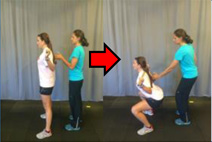 |
| 2. Good Morning | Assume half squat stance and position chest up with dowel rod in back squat position. Perform isolated trunk flexion while maintaining chest up. Maintain tight upper back throughout the exercise. Knee joint should slightly flex on the descent and straighten out on the ascent. | Exercise fortifies chest up position independent from trunk angle. | "Lower torso forward while keeping chest up" | 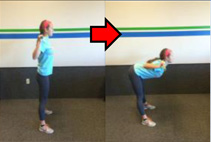 |
| 3. Squat with Overhead Press | Perform back squat. At apex of squat, hold position and press dowel straight up over head by extending elbows. Return dowel to back squat position and ascend back to starting position. | This exercise improves chest up positon during the apex of squat depth. | "Press dowel directly overhead" | 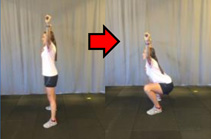 |
| STRENGTH/ STABILITY | ||||
| DEFICIT: Inability to maintain chest up position or scapular retraction, which may be due to weakness of the spinal erectors, trapeziuses or rhomboids. | ||||
| TARGETED CORRECTION: Improve upper back strength to develop stable upper torso for squat. | ||||
| Exercise | Description | Purpose | Cue | Example |
| 1. Band Pull Apart | Make two fists and hold arms straight out in front with palm side down. Pull arms slightly past 90° backward until shoulder blades pinch. Slowly return to start position. Grab both halves of the band and try a narrower grip for increased resistance. | To strengthen trapeziuses and rhomboids (parascapular muscles). | "Keep arms straight" | 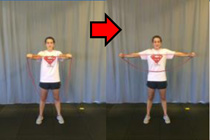 |
| 2. High Pull | Set up in quarter squat position with chest up and arms down straight. Hold dowel in overhand grip. Forcefully pull the dowel to clavicle height. Increase resistance as appropriate. | Improve upper back strength especially the trapezius muscles. | "Pull straight up" | 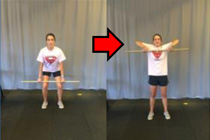 |
| 3. Front Squat | Hold lightweight object such as a small medicine ball or kettlebell at chest height. Perform squat exercise. Focus on maintaining upright torso. Increase resistance as appropriate. | Strengthen back musculature and promote postural control during squat. | "Lead with the object during ascent" | 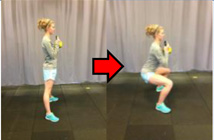 |
| MOBILITY | ||||
| DEFICIT: Excessive tightness in chest, potentially due to upper crossed syndrome, which hinders an individual's ability to open chest and retract scapulae. | ||||
| TARGETED CORRECTION: Improve pectoral and shoulder mobility. | ||||
| Exercise | Description | Purpose | Cue | Example |
| 1. Backward Arm Circles | Stand tall with arms straight and out to sides with palms up. Perform 10 reverse circles in a slow controlled motion. Start with small circles and work up to larger circles. | Improve pectoral and shoulder mobility. | "Slow, large controlled circles" | 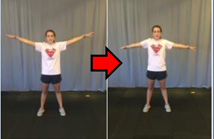 |
| 2. Wall Slides | Stand tall with back, head, and buttocks against a wall. Hold arms against the wall at 90 degree angles with palms outward. Extend arms upward as high as possible while attempting to keep back, head, and buttocks in contact with the wall. Hold for 10–15 seconds and return to starting position. Work to maintain maximum contact on the wall with the body as mastery improves. | Improve shoulder mobility. | "Keep back on the wall" | 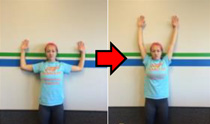 |
| 3. Scapular Press | Stand tall with dowel in back squat position. Perform a press to move the dowel above head with elbows extended. To accentuate the upward rotation of scapula, lift the shoulders upper towards the ears and feel the scapular rotate upward. Hold for 10 seconds. | Correct lack of upward rotation of the scapula. | "Press shoulders up and extend" | 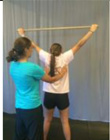 |
